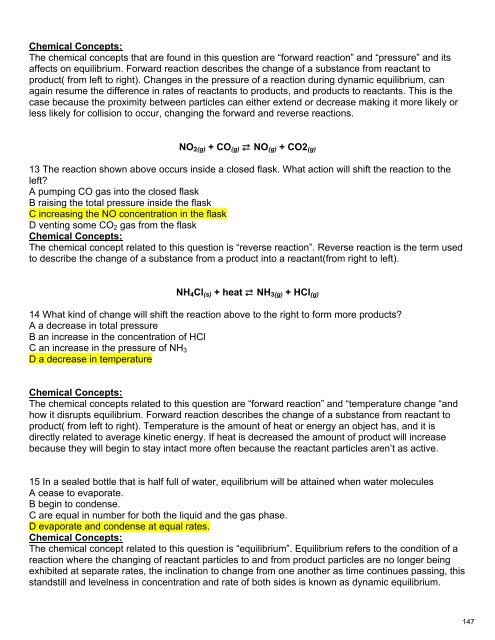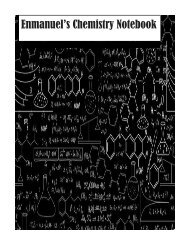Create successful ePaper yourself
Turn your PDF publications into a flip-book with our unique Google optimized e-Paper software.
<strong>Chem</strong>ical Concepts:<br />
The chemical concepts that are found in this question are “forward reaction” and “pressure” and its<br />
affects on equilibrium. Forward reaction describes the change of a substance from reactant to<br />
product( from left to right). Changes in the pressure of a reaction during dynamic equilibrium, can<br />
again resume the difference in rates of reactants to products, and products to reactants. This is the<br />
case because the proximity between particles can either extend or decrease making it more likely or<br />
less likely for collision to occur, changing the forward and reverse reactions.<br />
NO 2(g) + CO (g) ⇄ NO (g) + CO2 (g)<br />
13 The reaction shown above occurs inside a closed flask. What action will shift the reaction to the<br />
left?<br />
A pumping CO gas into the closed flask<br />
B raising the total pressure inside the flask<br />
C increasing the NO concentration in the flask<br />
D venting some CO 2 gas from the flask<br />
<strong>Chem</strong>ical Concepts:<br />
The chemical concept related to this question is “reverse reaction”. Reverse reaction is the term used<br />
to describe the change of a substance from a product into a reactant(from right to left).<br />
NH 4 Cl (s) + heat ⇄ NH 3(g) + HCl (g)<br />
14 What kind of change will shift the reaction above to the right to form more products?<br />
A a decrease in total pressure<br />
B an increase in the concentration of HCl<br />
C an increase in the pressure of NH 3<br />
D a decrease in temperature<br />
<strong>Chem</strong>ical Concepts:<br />
The chemical concepts related to this question are “forward reaction” and “temperature change “and<br />
how it disrupts equilibrium. Forward reaction describes the change of a substance from reactant to<br />
product( from left to right). Temperature is the amount of heat or energy an object has, and it is<br />
directly related to average kinetic energy. If heat is decreased the amount of product will increase<br />
because they will begin to stay intact more often because the reactant particles aren’t as active.<br />
15 In a sealed bottle that is half full of water, equilibrium will be attained when water molecules<br />
A cease to evaporate.<br />
B begin to condense.<br />
C are equal in number for both the liquid and the gas phase.<br />
D evaporate and condense at equal rates.<br />
<strong>Chem</strong>ical Concepts:<br />
The chemical concept related to this question is “equilibrium”. Equilibrium refers to the condition of a<br />
reaction where the changing of reactant particles to and from product particles are no longer being<br />
exhibited at separate rates, the inclination to change from one another as time continues passing, this<br />
standstill and levelness in concentration and rate of both sides is known as dynamic equilibrium.




